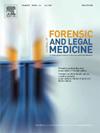Determinant factors in the identification of unknown cadavers in a forensic medical institute
IF 1.2
4区 医学
Q3 MEDICINE, LEGAL
引用次数: 0
Abstract
Introduction
Globally, efforts are being made to locate and identify as many missing people as possible, due to the social and legal importance of this process. Brazilian law 13.812/2019 established the National Policy for the Search for Missing Persons, prioritizing the search and identification of missing persons by public security agencies.
Objective
To evaluate factors related to the identification of unknown bodies that arrived at a Brazilian Medical Examiner's Institute.
Method
This was an epidemiological, cross-sectional study aiming to describe the characteristics of unidentified individuals in 2021 and factors related to their identification. A descriptive analysis, Pearson's Chi-square test with Monte Carlo simulation, and prevalence ratios obtained through Poisson regression were conducted.
Results
A total of 3649 individuals were examined, with a higher prevalence of male individuals and adults, whose cause of death was undetermined. Among them, 1046 arrived at the institute unidentified, while the rest were identified upon admission. Proportionally, there were more men and young people among the unidentified compared to those already identified upon arrival at the Institute. Of the 1046 unidentified individuals, most were recognized by family members, with 30 % identified technically, predominantly through fingerprint analysis. There were proportionally more unidentified individuals who were still unidentified and lacked information on sex, age, and cause of death compared to those who were identified. Fingerprint collection and the issuance of comparative anthropological/odontological reports were statistically significant for the identification process, and there was a higher chance of identification among unidentified females or individuals up to 17 years old, who represented a smaller number of cases, which improved the targeting of direct comparison between antemortem and postmortem data.
Conclusions
Fingerprint collection is especially important for the identification process. Defining or predicting the biological profile of the unidentified is crucial for the direct comparison of cases, making forensic anthropology services essential for critical cases involving cadaveric transformation, especially when there is the possibility of issuing comparative reports.
法医鉴定未知尸体的决定性因素
在全球范围内,由于这一进程的社会和法律重要性,正在努力寻找和查明尽可能多的失踪人员。巴西第13.812/2019号法律确立了《寻找失踪人员国家政策》,优先考虑公共安全机构寻找和识别失踪人员。目的评估巴西法医研究所对未知尸体的鉴定相关因素。方法采用流行病学横断面研究方法,旨在描述2021年身份不明个体的特征及其身份识别相关因素。描述性分析,蒙特卡罗模拟Pearson卡方检验,泊松回归得到患病率。结果共检查3649例,男性和成人患病率较高,死亡原因不明。其中1046人在进入研究所时身份不明,其余的人在进入研究所时身份不明。从比例上看,身份不明的男子和年轻人比到达研究所时已经确定身份的人要多。在1046个身份不明的人中,大多数是由家庭成员认出的,其中30%是通过指纹分析进行技术鉴定的。与已查明身份的人相比,仍未查明身份且缺乏性别、年龄和死亡原因信息的身份不明的人所占比例更高。指纹采集和比较人类学/牙科学报告的发布在识别过程中具有统计学意义,并且在身份不明的女性或17岁以下的个体中有更高的识别机会,这代表了较少的病例,这提高了在死前和死后数据之间直接比较的针对性。结论指纹采集在鉴别过程中尤为重要。确定或预测身份不明者的生物学特征对案件的直接比较至关重要,使法医人类学服务对涉及尸体转变的重大案件至关重要,特别是在有可能发布比较报告的情况下。
本文章由计算机程序翻译,如有差异,请以英文原文为准。
求助全文
约1分钟内获得全文
求助全文
来源期刊

Journal of forensic and legal medicine
MEDICINE, LEGAL-
CiteScore
2.70
自引率
6.70%
发文量
106
审稿时长
57 days
期刊介绍:
The Journal of Forensic and Legal Medicine publishes topical articles on aspects of forensic and legal medicine. Specifically the Journal supports research that explores the medical principles of care and forensic assessment of individuals, whether adult or child, in contact with the judicial system. It is a fully peer-review hybrid journal with a broad international perspective.
The Journal accepts submissions of original research, review articles, and pertinent case studies, editorials, and commentaries in relevant areas of Forensic and Legal Medicine, Context of Practice, and Education and Training.
The Journal adheres to strict publication ethical guidelines, and actively supports a culture of inclusive and representative publication.
 求助内容:
求助内容: 应助结果提醒方式:
应助结果提醒方式:


